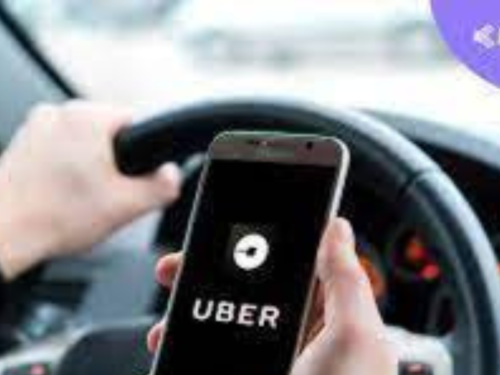Uber Joins The Advertising Bandwagon To Boost Digital Ad Revenue
Uber has now launched its advertising division and unveiled Journey Ads, its in-app advertising solution in an attempt to increase revenue. The global ride-hailing service will sell ad space inside its Uber Rides and Uber Eats apps as well as in other ad formats.
Journey Ads will be headed by advertising veteran Dr. Mark Grether, previously with Amazon Advertising, CEO of Sizmek, and Co-Founder of Xaxis. Uber will leverage its first-party data and insights across its mobility and delivery businesses, an audience of 122 million monthly active users. Brands can scale campaigns across both Uber apps.
The company describes journey ads as “an engaging way for brands to connect with consumers throughout the entire ride process.” Search engine land reports that the ad will be shown in the Uber app at least three times during the riders’ journey. Advertisers will be able to place ads based on riders’ travel histories and their exact geographic locations with the new feature. Using an example from The Wall Street Journal, a company can buy ads focused on a retailer, cinema, or airport where users book an Uber.
Interesting Read: The Ultimate A-Z Glossary Of Digital Advertising!
How do the ads work?
Additionally, Search Engine Land reports that the new product will allow brands to sponsor a rider’s entire trip from the start. In contrast to digital advertising’s usual model of charging per impression, the ad spots will be sold per trip. Uber riders will deliver ads in the app: while waiting for a car, during the journey in the car, and upon reaching the destination. The rider can also conduct transactions without leaving the app by clicking the ad to buy a product.
Though not available globally yet, Uber is testing the ads with a few brands at launch. Over 40 marquee brands have already partnered with Uber to run Journey Ads including NBCUniversal, Heineken, and United Artists Releasing. Early research shows that users exposed to ad content for 2 minutes resulted in two to six times the brand-performance lift compared to other benchmarks.
Uber will also enable ads in Uber Eats, at different stages during the food ordering process — from opening the app to checking out.
Other Advertising Options
Aside from Journey Ads, the list of ad formats is long. The platform will allow brands to purchase sponsored listings on Uber eats, sponsored emails, homepage “billboards”, post-checkout ads, in- Menu ads, and digital out-of-home car-top ads.
Uber is also doing Storefront ads that enable CPG brands to enjoy top digital shelf placement within its app as well as in-car tablet ads pilot in Los Angeles and San Francisco.
Uber not only connects the brands with relevant users but also provides comprehensive reporting and analysis of the effectiveness of those ads and whether they are able to capture the attention of all the movers and eaters.
Dr. Grether, General Manager, for Uber’s advertising division said in a statement,
“By tapping into our mobility media network, our pilot campaigns have surpassed expectations in terms of brand lift, engagement, and other campaign goals. We’re eager to continue working with our partners to identify best-in-class offerings – such as in-car tablet advertising – that will ensure they’re engaging with captive and engaged audiences.”
Targeting capabilities
A Wall Street Journal article says Uber’s advertising policy prohibits targeting users based on race, religion, or sexual orientation, as well as certain types of destinations, such as government buildings, hospitals, and reproductive health centers, based on ad targeting.
Uber is committed to privacy and will not share user data with advertisers. The information that the company shares is limited to aggregated information or data related to ad campaign performance. Uber users have the option of opting out of targeted ads at any time. Uber announced the move after Lyft launched its own advertising division in August, its main competitor in Western markets. Dr. Grether, General Manager also said,
“We have a global audience of valuable, purchase-minded consumers who, as part of our core business, tell us where they want to go and what they want to get.
While these consumers are making purchase decisions and waiting for their destination or delivery we can engage them with messages from brands that are relevant to their purchase journeys. And with 1.87 billion trips last quarter, that means we can connect advertisers to consumers on average five times per month across rides and delivery.”
Interesting Read: 6 Data Privacy Trends To Look Out For In 2022!
Author Profile

- Neha Mehta
- Neha started her journey as a financial professional but soon realized her passion for writing and is now living her dreams as a content writer. Her goal is to enlighten the audience on various topics through her writing and in-depth research. She is geeky and friendly. When not busy writing, she is spending time with her little one or travelling.
Latest Posts
 Interview and Guest PostJuly 19, 2024Navigating Ad Tech: Equativ’s Jacqueline Chua’s Strategic Insights
Interview and Guest PostJuly 19, 2024Navigating Ad Tech: Equativ’s Jacqueline Chua’s Strategic Insights Interview and Guest PostJune 21, 2024CTV Exploration: Chandrahas Shetty, Demand Facilitation Lead, India, On Growth And Privacy
Interview and Guest PostJune 21, 2024CTV Exploration: Chandrahas Shetty, Demand Facilitation Lead, India, On Growth And Privacy Interview and Guest PostJune 14, 2024Advertising Evolution: Rasha El-Ghoussaini on Snap Inc.
Interview and Guest PostJune 14, 2024Advertising Evolution: Rasha El-Ghoussaini on Snap Inc. Interview and Guest PostJune 5, 2024Navigating Digital Waves: Shrenik Gandhi’s Journey with WRM
Interview and Guest PostJune 5, 2024Navigating Digital Waves: Shrenik Gandhi’s Journey with WRM










